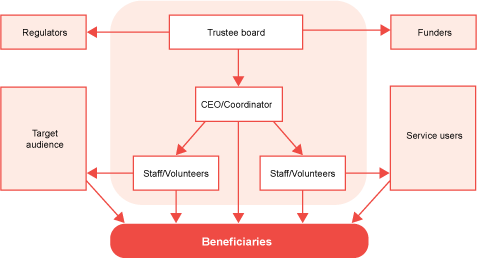The structure of typical voluntary organisations
The voluntary sector has much in common with other sectors in terms of the legal requirements for business and employment, the nature of many of the tasks that need to be done and the organisational structures that support these activities. There are ways though in which the voluntary sector is unique and one of these relates to the ownership of the organisation.
Figure 3 illustrates a typical charity structure, which includes a board of trustees who are responsible for the strategic direction of the charity and overseeing administration and management.
The CEO/coordinator/director will be the main point of contact between the board and the staff/volunteers.
Volunteers are a key element of voluntary organisations.
Beneficiaries are often the people being helped by the organisation.
The target audience might be members or beneficiaries, but could be different if the organisation seeks to influence government for example.
The regulators include the Charity Commission/OSCR/ CCNI, Companies House, HMRC.
The funders may include the people that you’re trying to influence (for example the government).
Some charities also have members, for example The National Trust.
You will now look at some of these in more detail.
Why do we have charities?

